Microeconomics: Operation Barga, Ethical and Economic Analysis
VerifiedAdded on 2022/10/19
|12
|2861
|13
Homework Assignment
AI Summary
This assignment delves into a microeconomic analysis of 'Operation Barga,' a land reform initiative implemented in West Bengal, India. The solution examines the program's impact on sharecroppers and landowners, exploring its ethical dimensions through consequentialism and deontological ethics. It evaluates the policy's alignment with Pareto improvement and efficiency. Furthermore, the assignment uses economic models to analyze the trade-offs between leisure time and income for farmers, both as independent producers and as sharecroppers. The analysis includes graphical representations to illustrate these concepts, offering a comprehensive understanding of the economic and ethical implications of the land reform program. The assignment concludes by comparing the outcomes for the farmer under different scenarios.
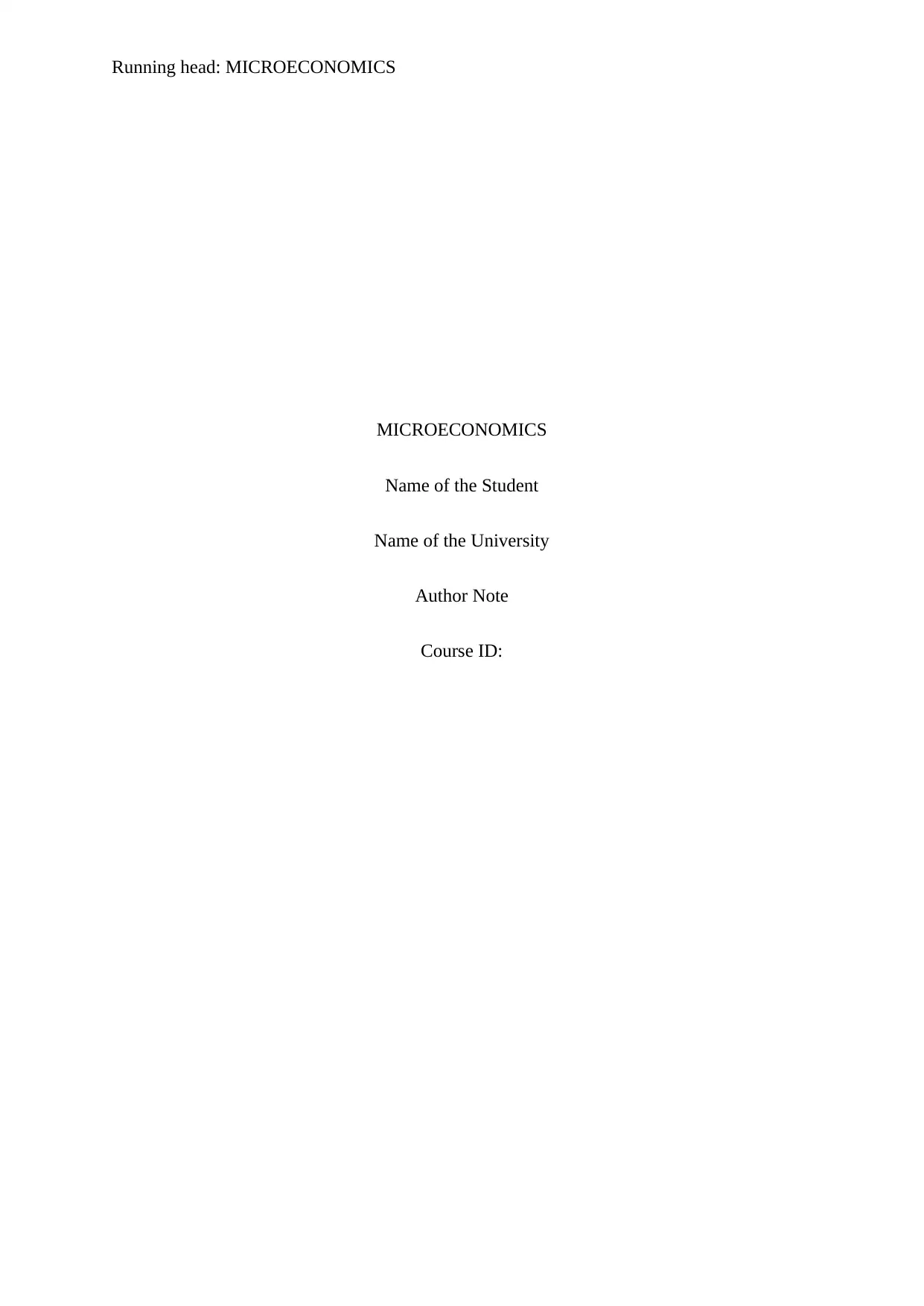
Running head: MICROECONOMICS
MICROECONOMICS
Name of the Student
Name of the University
Author Note
Course ID:
MICROECONOMICS
Name of the Student
Name of the University
Author Note
Course ID:
Secure Best Marks with AI Grader
Need help grading? Try our AI Grader for instant feedback on your assignments.
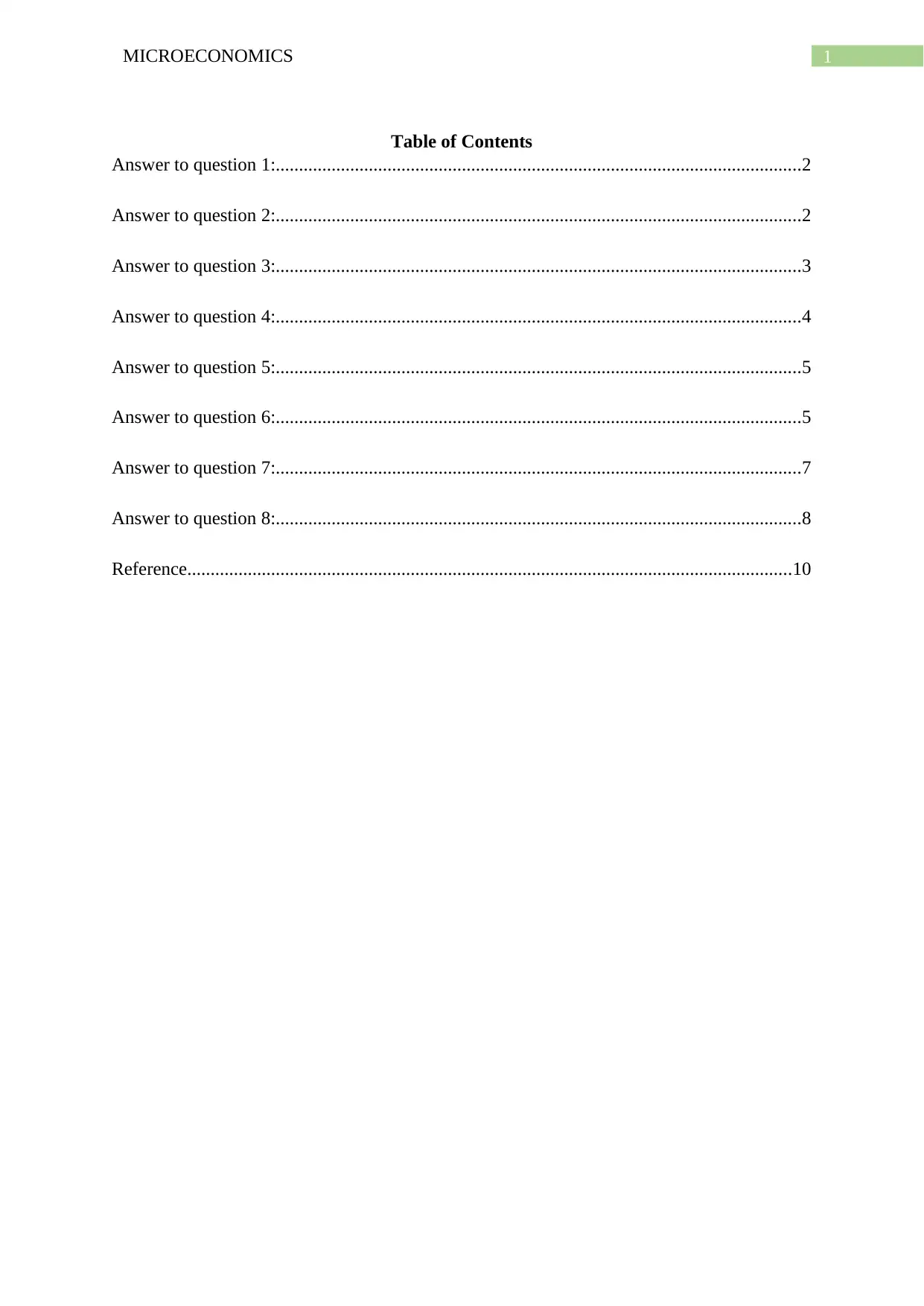
1MICROECONOMICS
Table of Contents
Answer to question 1:.................................................................................................................2
Answer to question 2:.................................................................................................................2
Answer to question 3:.................................................................................................................3
Answer to question 4:.................................................................................................................4
Answer to question 5:.................................................................................................................5
Answer to question 6:.................................................................................................................5
Answer to question 7:.................................................................................................................7
Answer to question 8:.................................................................................................................8
Reference..................................................................................................................................10
Table of Contents
Answer to question 1:.................................................................................................................2
Answer to question 2:.................................................................................................................2
Answer to question 3:.................................................................................................................3
Answer to question 4:.................................................................................................................4
Answer to question 5:.................................................................................................................5
Answer to question 6:.................................................................................................................5
Answer to question 7:.................................................................................................................7
Answer to question 8:.................................................................................................................8
Reference..................................................................................................................................10
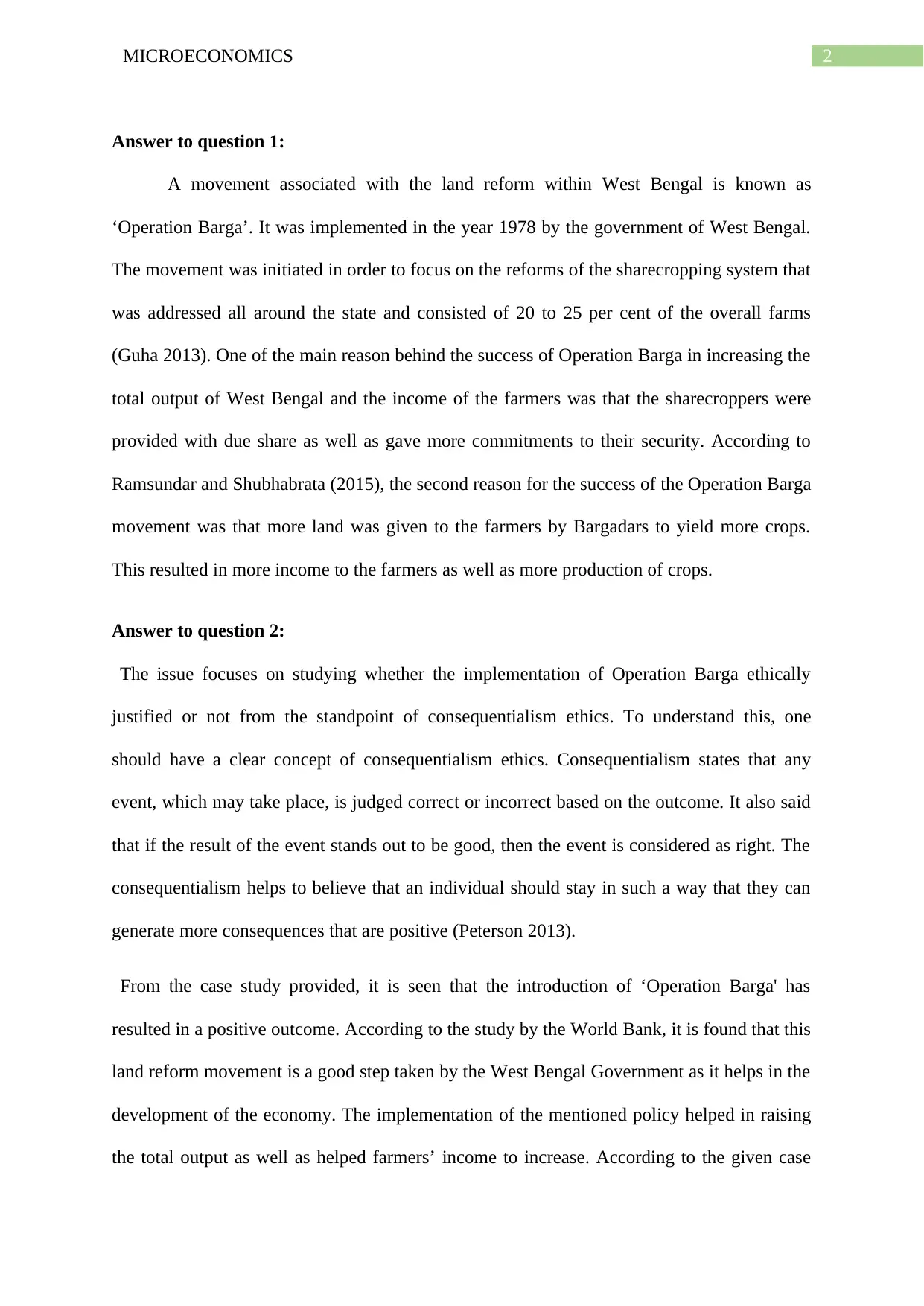
2MICROECONOMICS
Answer to question 1:
A movement associated with the land reform within West Bengal is known as
‘Operation Barga’. It was implemented in the year 1978 by the government of West Bengal.
The movement was initiated in order to focus on the reforms of the sharecropping system that
was addressed all around the state and consisted of 20 to 25 per cent of the overall farms
(Guha 2013). One of the main reason behind the success of Operation Barga in increasing the
total output of West Bengal and the income of the farmers was that the sharecroppers were
provided with due share as well as gave more commitments to their security. According to
Ramsundar and Shubhabrata (2015), the second reason for the success of the Operation Barga
movement was that more land was given to the farmers by Bargadars to yield more crops.
This resulted in more income to the farmers as well as more production of crops.
Answer to question 2:
The issue focuses on studying whether the implementation of Operation Barga ethically
justified or not from the standpoint of consequentialism ethics. To understand this, one
should have a clear concept of consequentialism ethics. Consequentialism states that any
event, which may take place, is judged correct or incorrect based on the outcome. It also said
that if the result of the event stands out to be good, then the event is considered as right. The
consequentialism helps to believe that an individual should stay in such a way that they can
generate more consequences that are positive (Peterson 2013).
From the case study provided, it is seen that the introduction of ‘Operation Barga' has
resulted in a positive outcome. According to the study by the World Bank, it is found that this
land reform movement is a good step taken by the West Bengal Government as it helps in the
development of the economy. The implementation of the mentioned policy helped in raising
the total output as well as helped farmers’ income to increase. According to the given case
Answer to question 1:
A movement associated with the land reform within West Bengal is known as
‘Operation Barga’. It was implemented in the year 1978 by the government of West Bengal.
The movement was initiated in order to focus on the reforms of the sharecropping system that
was addressed all around the state and consisted of 20 to 25 per cent of the overall farms
(Guha 2013). One of the main reason behind the success of Operation Barga in increasing the
total output of West Bengal and the income of the farmers was that the sharecroppers were
provided with due share as well as gave more commitments to their security. According to
Ramsundar and Shubhabrata (2015), the second reason for the success of the Operation Barga
movement was that more land was given to the farmers by Bargadars to yield more crops.
This resulted in more income to the farmers as well as more production of crops.
Answer to question 2:
The issue focuses on studying whether the implementation of Operation Barga ethically
justified or not from the standpoint of consequentialism ethics. To understand this, one
should have a clear concept of consequentialism ethics. Consequentialism states that any
event, which may take place, is judged correct or incorrect based on the outcome. It also said
that if the result of the event stands out to be good, then the event is considered as right. The
consequentialism helps to believe that an individual should stay in such a way that they can
generate more consequences that are positive (Peterson 2013).
From the case study provided, it is seen that the introduction of ‘Operation Barga' has
resulted in a positive outcome. According to the study by the World Bank, it is found that this
land reform movement is a good step taken by the West Bengal Government as it helps in the
development of the economy. The implementation of the mentioned policy helped in raising
the total output as well as helped farmers’ income to increase. According to the given case
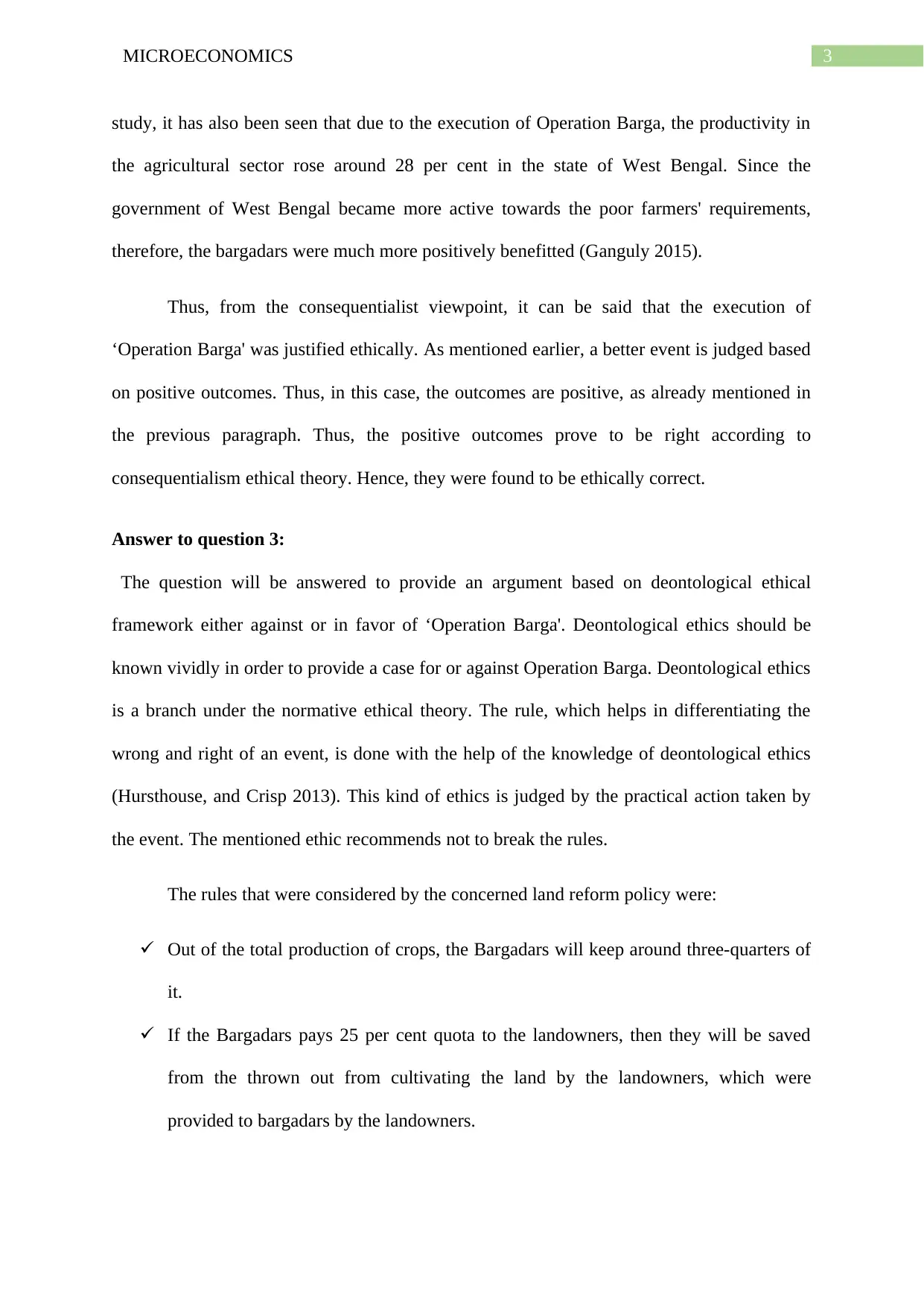
3MICROECONOMICS
study, it has also been seen that due to the execution of Operation Barga, the productivity in
the agricultural sector rose around 28 per cent in the state of West Bengal. Since the
government of West Bengal became more active towards the poor farmers' requirements,
therefore, the bargadars were much more positively benefitted (Ganguly 2015).
Thus, from the consequentialist viewpoint, it can be said that the execution of
‘Operation Barga' was justified ethically. As mentioned earlier, a better event is judged based
on positive outcomes. Thus, in this case, the outcomes are positive, as already mentioned in
the previous paragraph. Thus, the positive outcomes prove to be right according to
consequentialism ethical theory. Hence, they were found to be ethically correct.
Answer to question 3:
The question will be answered to provide an argument based on deontological ethical
framework either against or in favor of ‘Operation Barga'. Deontological ethics should be
known vividly in order to provide a case for or against Operation Barga. Deontological ethics
is a branch under the normative ethical theory. The rule, which helps in differentiating the
wrong and right of an event, is done with the help of the knowledge of deontological ethics
(Hursthouse, and Crisp 2013). This kind of ethics is judged by the practical action taken by
the event. The mentioned ethic recommends not to break the rules.
The rules that were considered by the concerned land reform policy were:
Out of the total production of crops, the Bargadars will keep around three-quarters of
it.
If the Bargadars pays 25 per cent quota to the landowners, then they will be saved
from the thrown out from cultivating the land by the landowners, which were
provided to bargadars by the landowners.
study, it has also been seen that due to the execution of Operation Barga, the productivity in
the agricultural sector rose around 28 per cent in the state of West Bengal. Since the
government of West Bengal became more active towards the poor farmers' requirements,
therefore, the bargadars were much more positively benefitted (Ganguly 2015).
Thus, from the consequentialist viewpoint, it can be said that the execution of
‘Operation Barga' was justified ethically. As mentioned earlier, a better event is judged based
on positive outcomes. Thus, in this case, the outcomes are positive, as already mentioned in
the previous paragraph. Thus, the positive outcomes prove to be right according to
consequentialism ethical theory. Hence, they were found to be ethically correct.
Answer to question 3:
The question will be answered to provide an argument based on deontological ethical
framework either against or in favor of ‘Operation Barga'. Deontological ethics should be
known vividly in order to provide a case for or against Operation Barga. Deontological ethics
is a branch under the normative ethical theory. The rule, which helps in differentiating the
wrong and right of an event, is done with the help of the knowledge of deontological ethics
(Hursthouse, and Crisp 2013). This kind of ethics is judged by the practical action taken by
the event. The mentioned ethic recommends not to break the rules.
The rules that were considered by the concerned land reform policy were:
Out of the total production of crops, the Bargadars will keep around three-quarters of
it.
If the Bargadars pays 25 per cent quota to the landowners, then they will be saved
from the thrown out from cultivating the land by the landowners, which were
provided to bargadars by the landowners.
Secure Best Marks with AI Grader
Need help grading? Try our AI Grader for instant feedback on your assignments.
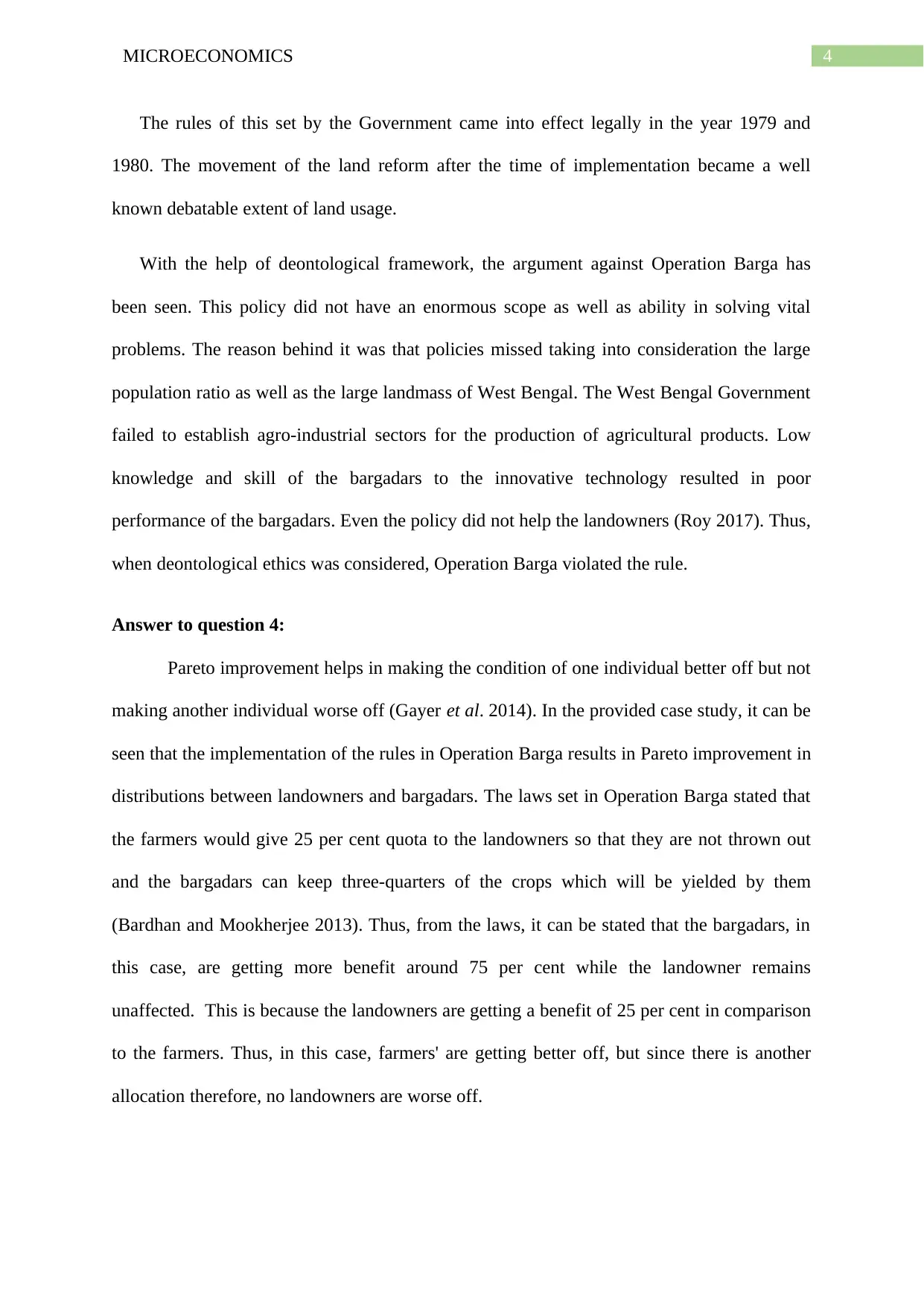
4MICROECONOMICS
The rules of this set by the Government came into effect legally in the year 1979 and
1980. The movement of the land reform after the time of implementation became a well
known debatable extent of land usage.
With the help of deontological framework, the argument against Operation Barga has
been seen. This policy did not have an enormous scope as well as ability in solving vital
problems. The reason behind it was that policies missed taking into consideration the large
population ratio as well as the large landmass of West Bengal. The West Bengal Government
failed to establish agro-industrial sectors for the production of agricultural products. Low
knowledge and skill of the bargadars to the innovative technology resulted in poor
performance of the bargadars. Even the policy did not help the landowners (Roy 2017). Thus,
when deontological ethics was considered, Operation Barga violated the rule.
Answer to question 4:
Pareto improvement helps in making the condition of one individual better off but not
making another individual worse off (Gayer et al. 2014). In the provided case study, it can be
seen that the implementation of the rules in Operation Barga results in Pareto improvement in
distributions between landowners and bargadars. The laws set in Operation Barga stated that
the farmers would give 25 per cent quota to the landowners so that they are not thrown out
and the bargadars can keep three-quarters of the crops which will be yielded by them
(Bardhan and Mookherjee 2013). Thus, from the laws, it can be stated that the bargadars, in
this case, are getting more benefit around 75 per cent while the landowner remains
unaffected. This is because the landowners are getting a benefit of 25 per cent in comparison
to the farmers. Thus, in this case, farmers' are getting better off, but since there is another
allocation therefore, no landowners are worse off.
The rules of this set by the Government came into effect legally in the year 1979 and
1980. The movement of the land reform after the time of implementation became a well
known debatable extent of land usage.
With the help of deontological framework, the argument against Operation Barga has
been seen. This policy did not have an enormous scope as well as ability in solving vital
problems. The reason behind it was that policies missed taking into consideration the large
population ratio as well as the large landmass of West Bengal. The West Bengal Government
failed to establish agro-industrial sectors for the production of agricultural products. Low
knowledge and skill of the bargadars to the innovative technology resulted in poor
performance of the bargadars. Even the policy did not help the landowners (Roy 2017). Thus,
when deontological ethics was considered, Operation Barga violated the rule.
Answer to question 4:
Pareto improvement helps in making the condition of one individual better off but not
making another individual worse off (Gayer et al. 2014). In the provided case study, it can be
seen that the implementation of the rules in Operation Barga results in Pareto improvement in
distributions between landowners and bargadars. The laws set in Operation Barga stated that
the farmers would give 25 per cent quota to the landowners so that they are not thrown out
and the bargadars can keep three-quarters of the crops which will be yielded by them
(Bardhan and Mookherjee 2013). Thus, from the laws, it can be stated that the bargadars, in
this case, are getting more benefit around 75 per cent while the landowner remains
unaffected. This is because the landowners are getting a benefit of 25 per cent in comparison
to the farmers. Thus, in this case, farmers' are getting better off, but since there is another
allocation therefore, no landowners are worse off.
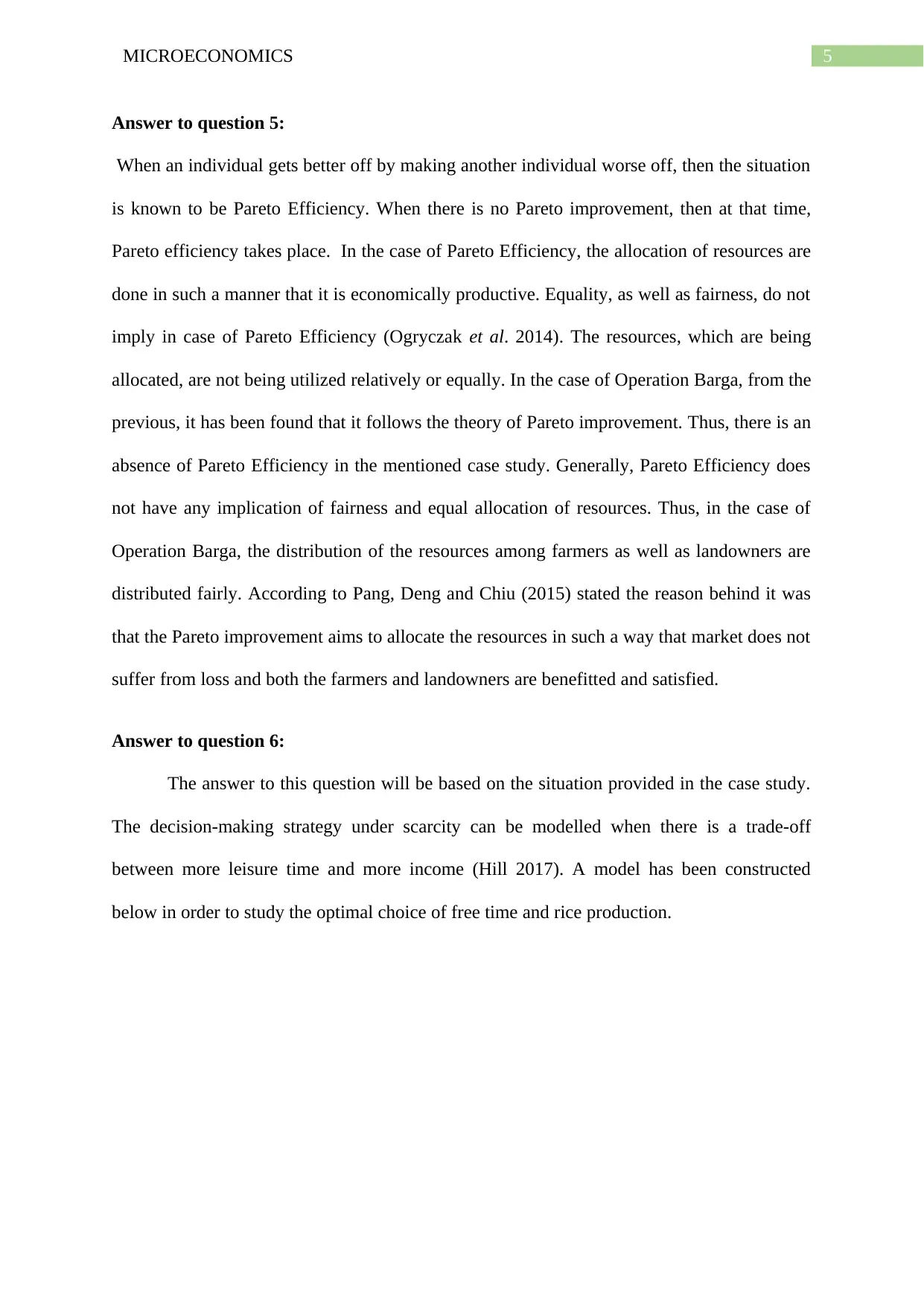
5MICROECONOMICS
Answer to question 5:
When an individual gets better off by making another individual worse off, then the situation
is known to be Pareto Efficiency. When there is no Pareto improvement, then at that time,
Pareto efficiency takes place. In the case of Pareto Efficiency, the allocation of resources are
done in such a manner that it is economically productive. Equality, as well as fairness, do not
imply in case of Pareto Efficiency (Ogryczak et al. 2014). The resources, which are being
allocated, are not being utilized relatively or equally. In the case of Operation Barga, from the
previous, it has been found that it follows the theory of Pareto improvement. Thus, there is an
absence of Pareto Efficiency in the mentioned case study. Generally, Pareto Efficiency does
not have any implication of fairness and equal allocation of resources. Thus, in the case of
Operation Barga, the distribution of the resources among farmers as well as landowners are
distributed fairly. According to Pang, Deng and Chiu (2015) stated the reason behind it was
that the Pareto improvement aims to allocate the resources in such a way that market does not
suffer from loss and both the farmers and landowners are benefitted and satisfied.
Answer to question 6:
The answer to this question will be based on the situation provided in the case study.
The decision-making strategy under scarcity can be modelled when there is a trade-off
between more leisure time and more income (Hill 2017). A model has been constructed
below in order to study the optimal choice of free time and rice production.
Answer to question 5:
When an individual gets better off by making another individual worse off, then the situation
is known to be Pareto Efficiency. When there is no Pareto improvement, then at that time,
Pareto efficiency takes place. In the case of Pareto Efficiency, the allocation of resources are
done in such a manner that it is economically productive. Equality, as well as fairness, do not
imply in case of Pareto Efficiency (Ogryczak et al. 2014). The resources, which are being
allocated, are not being utilized relatively or equally. In the case of Operation Barga, from the
previous, it has been found that it follows the theory of Pareto improvement. Thus, there is an
absence of Pareto Efficiency in the mentioned case study. Generally, Pareto Efficiency does
not have any implication of fairness and equal allocation of resources. Thus, in the case of
Operation Barga, the distribution of the resources among farmers as well as landowners are
distributed fairly. According to Pang, Deng and Chiu (2015) stated the reason behind it was
that the Pareto improvement aims to allocate the resources in such a way that market does not
suffer from loss and both the farmers and landowners are benefitted and satisfied.
Answer to question 6:
The answer to this question will be based on the situation provided in the case study.
The decision-making strategy under scarcity can be modelled when there is a trade-off
between more leisure time and more income (Hill 2017). A model has been constructed
below in order to study the optimal choice of free time and rice production.
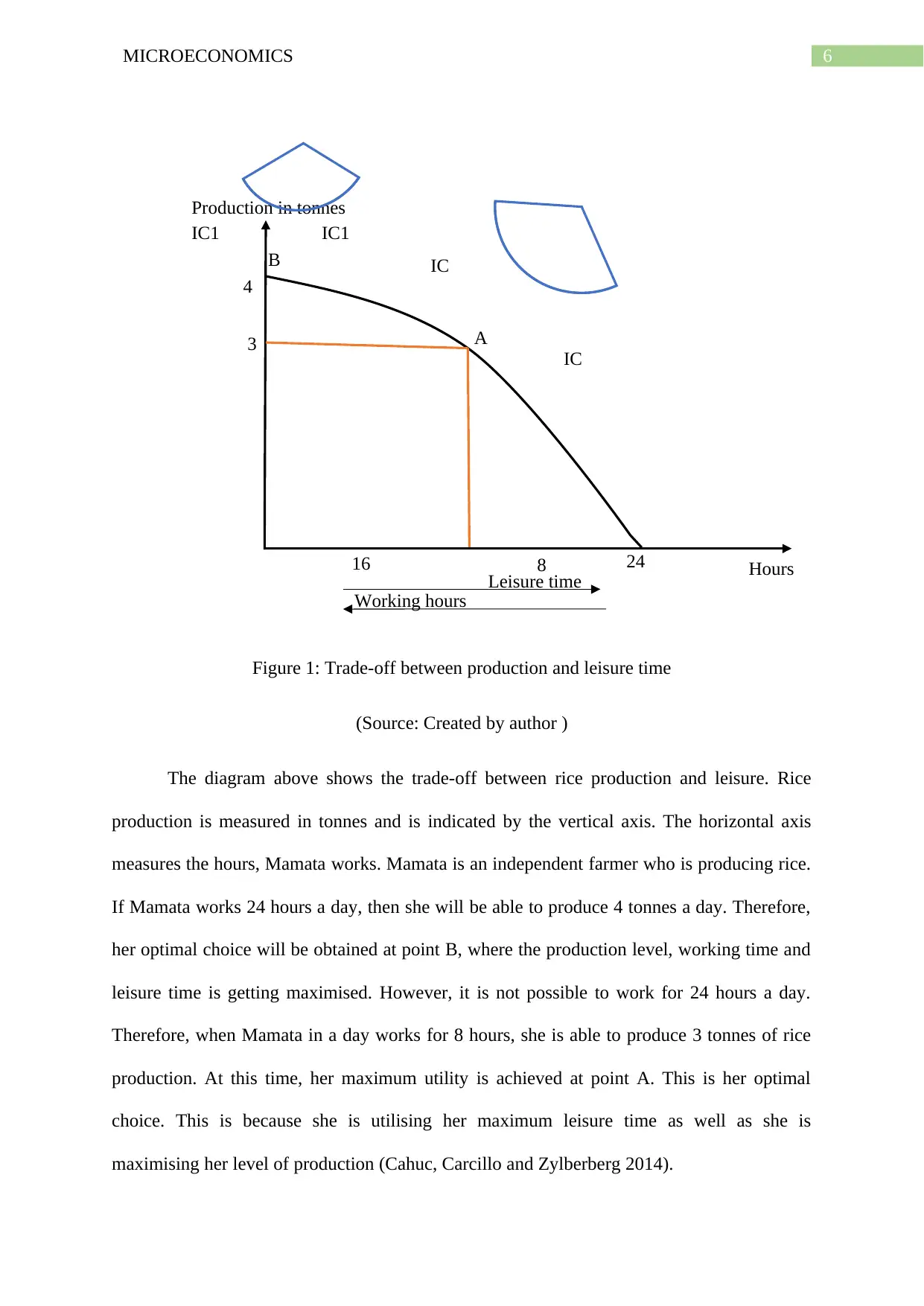
6MICROECONOMICS
8
A
4
24
IC
3
Hours
Working hours
Production in tonnes
Leisure time
IC
B
IC1 IC1
16
Figure 1: Trade-off between production and leisure time
(Source: Created by author )
The diagram above shows the trade-off between rice production and leisure. Rice
production is measured in tonnes and is indicated by the vertical axis. The horizontal axis
measures the hours, Mamata works. Mamata is an independent farmer who is producing rice.
If Mamata works 24 hours a day, then she will be able to produce 4 tonnes a day. Therefore,
her optimal choice will be obtained at point B, where the production level, working time and
leisure time is getting maximised. However, it is not possible to work for 24 hours a day.
Therefore, when Mamata in a day works for 8 hours, she is able to produce 3 tonnes of rice
production. At this time, her maximum utility is achieved at point A. This is her optimal
choice. This is because she is utilising her maximum leisure time as well as she is
maximising her level of production (Cahuc, Carcillo and Zylberberg 2014).
8
A
4
24
IC
3
Hours
Working hours
Production in tonnes
Leisure time
IC
B
IC1 IC1
16
Figure 1: Trade-off between production and leisure time
(Source: Created by author )
The diagram above shows the trade-off between rice production and leisure. Rice
production is measured in tonnes and is indicated by the vertical axis. The horizontal axis
measures the hours, Mamata works. Mamata is an independent farmer who is producing rice.
If Mamata works 24 hours a day, then she will be able to produce 4 tonnes a day. Therefore,
her optimal choice will be obtained at point B, where the production level, working time and
leisure time is getting maximised. However, it is not possible to work for 24 hours a day.
Therefore, when Mamata in a day works for 8 hours, she is able to produce 3 tonnes of rice
production. At this time, her maximum utility is achieved at point A. This is her optimal
choice. This is because she is utilising her maximum leisure time as well as she is
maximising her level of production (Cahuc, Carcillo and Zylberberg 2014).
Paraphrase This Document
Need a fresh take? Get an instant paraphrase of this document with our AI Paraphraser
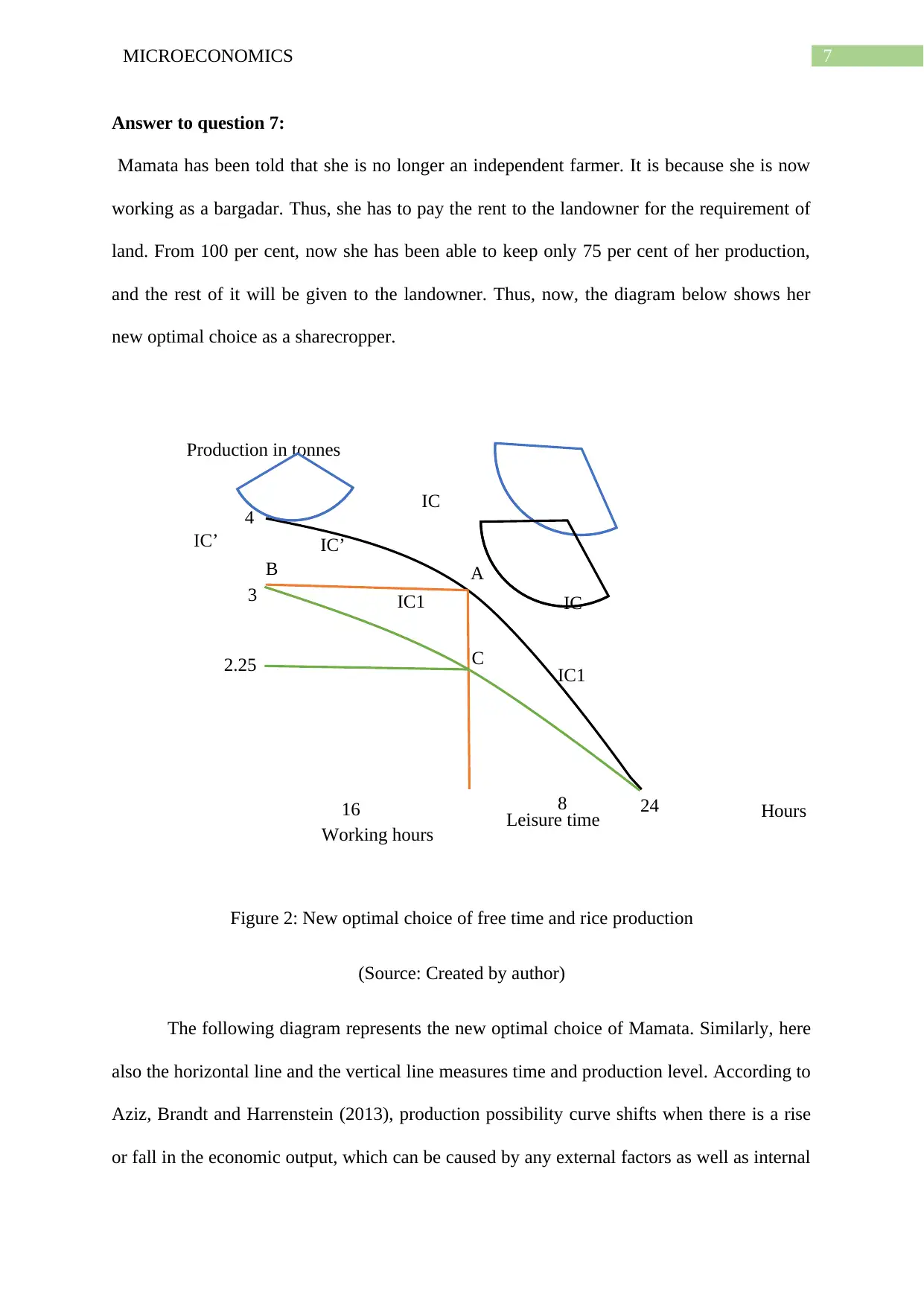
7MICROECONOMICS
IC
ICIC1
IC1
A
C
Production in tonnes
4
3
2.25
24 HoursLeisure time
Working hours
B
IC’ IC’
816
Answer to question 7:
Mamata has been told that she is no longer an independent farmer. It is because she is now
working as a bargadar. Thus, she has to pay the rent to the landowner for the requirement of
land. From 100 per cent, now she has been able to keep only 75 per cent of her production,
and the rest of it will be given to the landowner. Thus, now, the diagram below shows her
new optimal choice as a sharecropper.
Figure 2: New optimal choice of free time and rice production
(Source: Created by author)
The following diagram represents the new optimal choice of Mamata. Similarly, here
also the horizontal line and the vertical line measures time and production level. According to
Aziz, Brandt and Harrenstein (2013), production possibility curve shifts when there is a rise
or fall in the economic output, which can be caused by any external factors as well as internal
IC
ICIC1
IC1
A
C
Production in tonnes
4
3
2.25
24 HoursLeisure time
Working hours
B
IC’ IC’
816
Answer to question 7:
Mamata has been told that she is no longer an independent farmer. It is because she is now
working as a bargadar. Thus, she has to pay the rent to the landowner for the requirement of
land. From 100 per cent, now she has been able to keep only 75 per cent of her production,
and the rest of it will be given to the landowner. Thus, now, the diagram below shows her
new optimal choice as a sharecropper.
Figure 2: New optimal choice of free time and rice production
(Source: Created by author)
The following diagram represents the new optimal choice of Mamata. Similarly, here
also the horizontal line and the vertical line measures time and production level. According to
Aziz, Brandt and Harrenstein (2013), production possibility curve shifts when there is a rise
or fall in the economic output, which can be caused by any external factors as well as internal
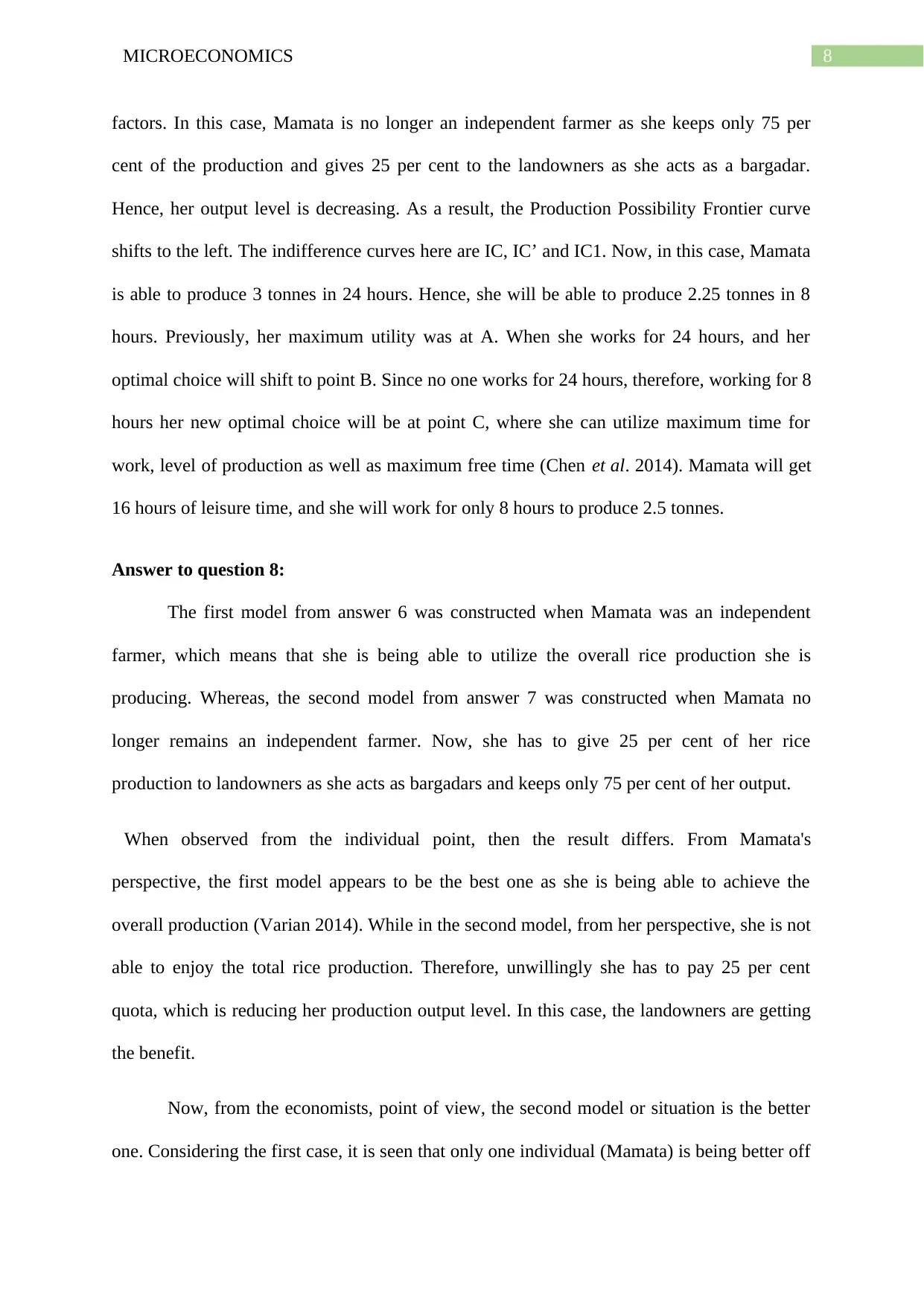
8MICROECONOMICS
factors. In this case, Mamata is no longer an independent farmer as she keeps only 75 per
cent of the production and gives 25 per cent to the landowners as she acts as a bargadar.
Hence, her output level is decreasing. As a result, the Production Possibility Frontier curve
shifts to the left. The indifference curves here are IC, IC’ and IC1. Now, in this case, Mamata
is able to produce 3 tonnes in 24 hours. Hence, she will be able to produce 2.25 tonnes in 8
hours. Previously, her maximum utility was at A. When she works for 24 hours, and her
optimal choice will shift to point B. Since no one works for 24 hours, therefore, working for 8
hours her new optimal choice will be at point C, where she can utilize maximum time for
work, level of production as well as maximum free time (Chen et al. 2014). Mamata will get
16 hours of leisure time, and she will work for only 8 hours to produce 2.5 tonnes.
Answer to question 8:
The first model from answer 6 was constructed when Mamata was an independent
farmer, which means that she is being able to utilize the overall rice production she is
producing. Whereas, the second model from answer 7 was constructed when Mamata no
longer remains an independent farmer. Now, she has to give 25 per cent of her rice
production to landowners as she acts as bargadars and keeps only 75 per cent of her output.
When observed from the individual point, then the result differs. From Mamata's
perspective, the first model appears to be the best one as she is being able to achieve the
overall production (Varian 2014). While in the second model, from her perspective, she is not
able to enjoy the total rice production. Therefore, unwillingly she has to pay 25 per cent
quota, which is reducing her production output level. In this case, the landowners are getting
the benefit.
Now, from the economists, point of view, the second model or situation is the better
one. Considering the first case, it is seen that only one individual (Mamata) is being better off
factors. In this case, Mamata is no longer an independent farmer as she keeps only 75 per
cent of the production and gives 25 per cent to the landowners as she acts as a bargadar.
Hence, her output level is decreasing. As a result, the Production Possibility Frontier curve
shifts to the left. The indifference curves here are IC, IC’ and IC1. Now, in this case, Mamata
is able to produce 3 tonnes in 24 hours. Hence, she will be able to produce 2.25 tonnes in 8
hours. Previously, her maximum utility was at A. When she works for 24 hours, and her
optimal choice will shift to point B. Since no one works for 24 hours, therefore, working for 8
hours her new optimal choice will be at point C, where she can utilize maximum time for
work, level of production as well as maximum free time (Chen et al. 2014). Mamata will get
16 hours of leisure time, and she will work for only 8 hours to produce 2.5 tonnes.
Answer to question 8:
The first model from answer 6 was constructed when Mamata was an independent
farmer, which means that she is being able to utilize the overall rice production she is
producing. Whereas, the second model from answer 7 was constructed when Mamata no
longer remains an independent farmer. Now, she has to give 25 per cent of her rice
production to landowners as she acts as bargadars and keeps only 75 per cent of her output.
When observed from the individual point, then the result differs. From Mamata's
perspective, the first model appears to be the best one as she is being able to achieve the
overall production (Varian 2014). While in the second model, from her perspective, she is not
able to enjoy the total rice production. Therefore, unwillingly she has to pay 25 per cent
quota, which is reducing her production output level. In this case, the landowners are getting
the benefit.
Now, from the economists, point of view, the second model or situation is the better
one. Considering the first case, it is seen that only one individual (Mamata) is being better off
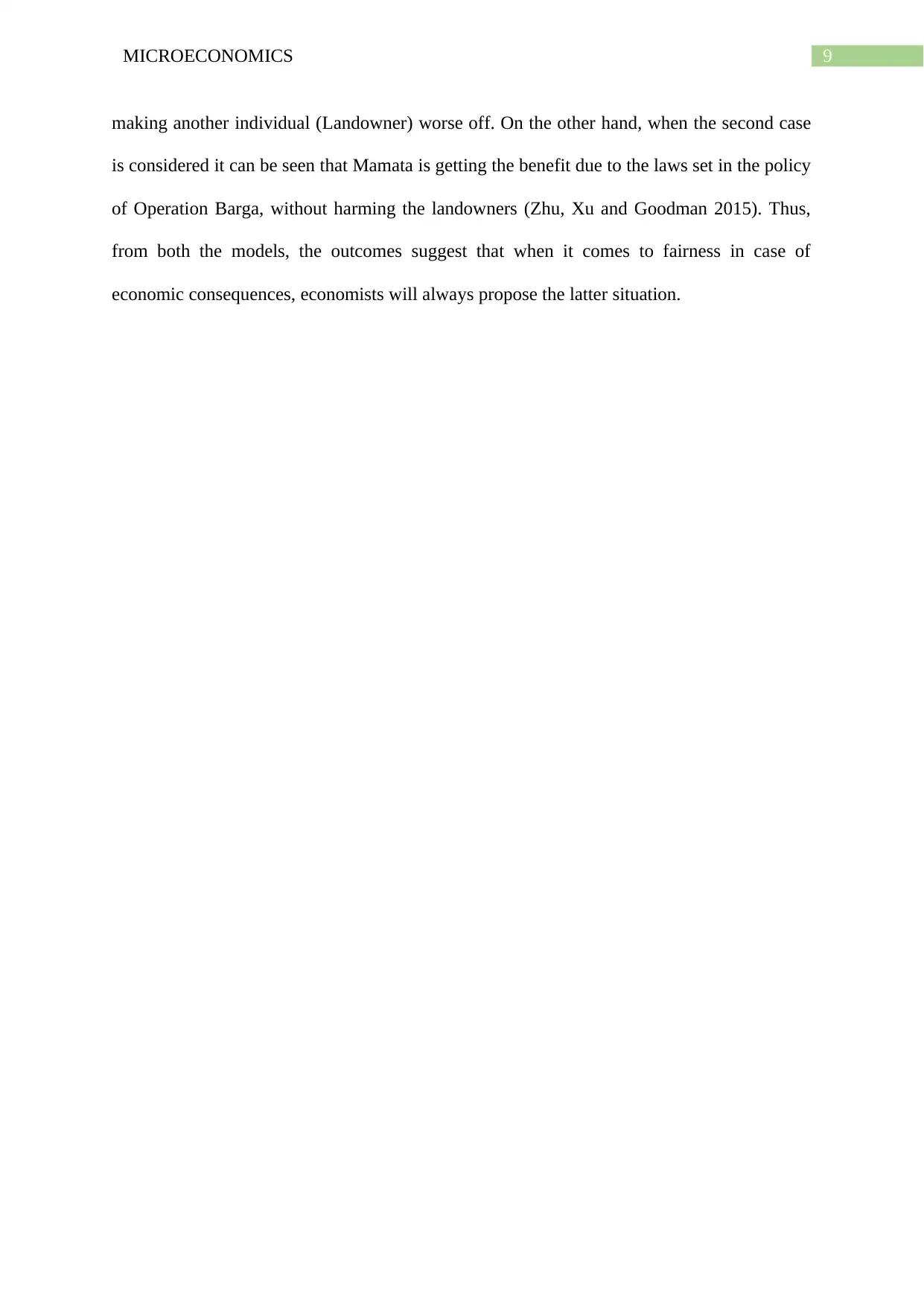
9MICROECONOMICS
making another individual (Landowner) worse off. On the other hand, when the second case
is considered it can be seen that Mamata is getting the benefit due to the laws set in the policy
of Operation Barga, without harming the landowners (Zhu, Xu and Goodman 2015). Thus,
from both the models, the outcomes suggest that when it comes to fairness in case of
economic consequences, economists will always propose the latter situation.
making another individual (Landowner) worse off. On the other hand, when the second case
is considered it can be seen that Mamata is getting the benefit due to the laws set in the policy
of Operation Barga, without harming the landowners (Zhu, Xu and Goodman 2015). Thus,
from both the models, the outcomes suggest that when it comes to fairness in case of
economic consequences, economists will always propose the latter situation.
Secure Best Marks with AI Grader
Need help grading? Try our AI Grader for instant feedback on your assignments.
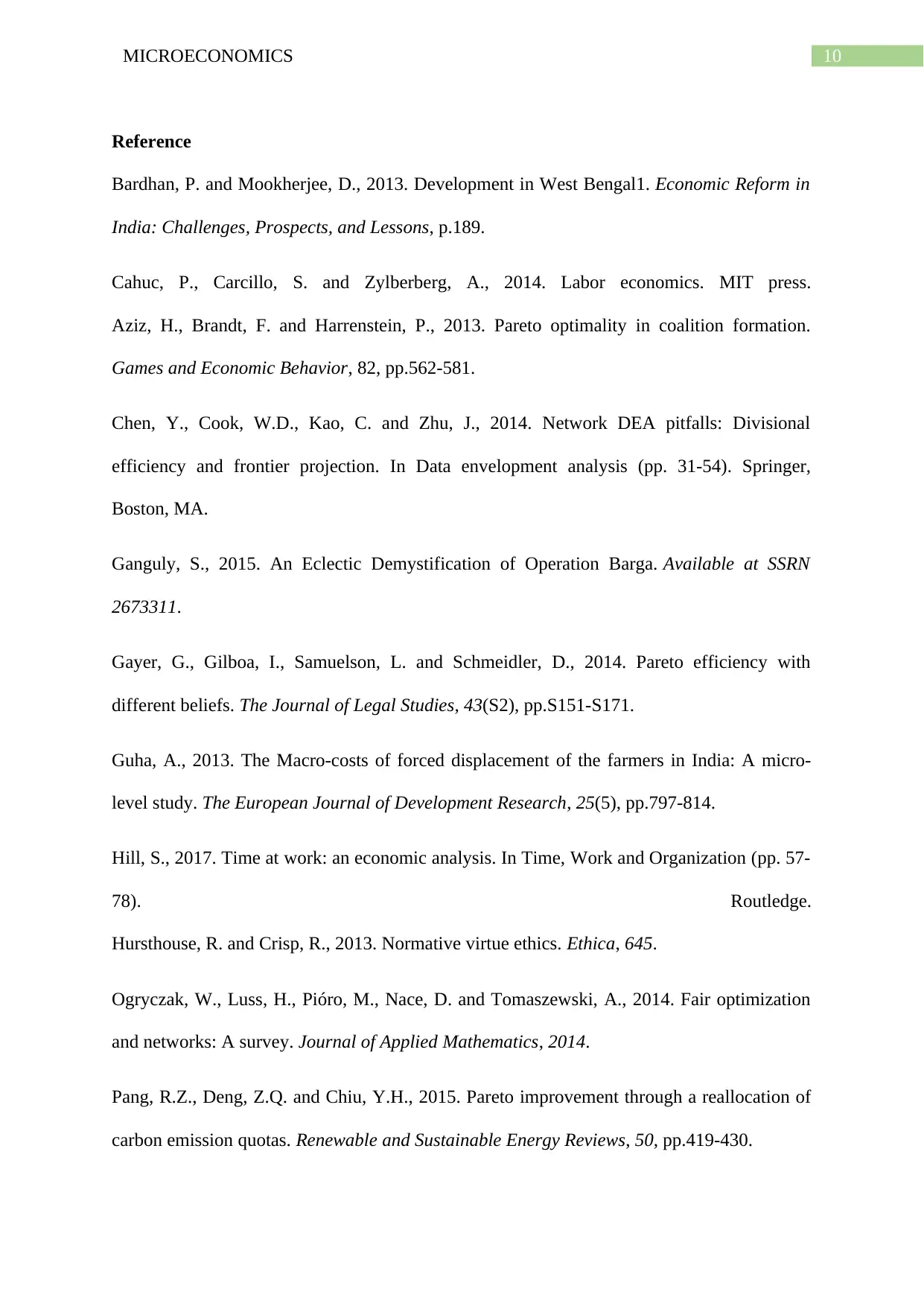
10MICROECONOMICS
Reference
Bardhan, P. and Mookherjee, D., 2013. Development in West Bengal1. Economic Reform in
India: Challenges, Prospects, and Lessons, p.189.
Cahuc, P., Carcillo, S. and Zylberberg, A., 2014. Labor economics. MIT press.
Aziz, H., Brandt, F. and Harrenstein, P., 2013. Pareto optimality in coalition formation.
Games and Economic Behavior, 82, pp.562-581.
Chen, Y., Cook, W.D., Kao, C. and Zhu, J., 2014. Network DEA pitfalls: Divisional
efficiency and frontier projection. In Data envelopment analysis (pp. 31-54). Springer,
Boston, MA.
Ganguly, S., 2015. An Eclectic Demystification of Operation Barga. Available at SSRN
2673311.
Gayer, G., Gilboa, I., Samuelson, L. and Schmeidler, D., 2014. Pareto efficiency with
different beliefs. The Journal of Legal Studies, 43(S2), pp.S151-S171.
Guha, A., 2013. The Macro-costs of forced displacement of the farmers in India: A micro-
level study. The European Journal of Development Research, 25(5), pp.797-814.
Hill, S., 2017. Time at work: an economic analysis. In Time, Work and Organization (pp. 57-
78). Routledge.
Hursthouse, R. and Crisp, R., 2013. Normative virtue ethics. Ethica, 645.
Ogryczak, W., Luss, H., Pióro, M., Nace, D. and Tomaszewski, A., 2014. Fair optimization
and networks: A survey. Journal of Applied Mathematics, 2014.
Pang, R.Z., Deng, Z.Q. and Chiu, Y.H., 2015. Pareto improvement through a reallocation of
carbon emission quotas. Renewable and Sustainable Energy Reviews, 50, pp.419-430.
Reference
Bardhan, P. and Mookherjee, D., 2013. Development in West Bengal1. Economic Reform in
India: Challenges, Prospects, and Lessons, p.189.
Cahuc, P., Carcillo, S. and Zylberberg, A., 2014. Labor economics. MIT press.
Aziz, H., Brandt, F. and Harrenstein, P., 2013. Pareto optimality in coalition formation.
Games and Economic Behavior, 82, pp.562-581.
Chen, Y., Cook, W.D., Kao, C. and Zhu, J., 2014. Network DEA pitfalls: Divisional
efficiency and frontier projection. In Data envelopment analysis (pp. 31-54). Springer,
Boston, MA.
Ganguly, S., 2015. An Eclectic Demystification of Operation Barga. Available at SSRN
2673311.
Gayer, G., Gilboa, I., Samuelson, L. and Schmeidler, D., 2014. Pareto efficiency with
different beliefs. The Journal of Legal Studies, 43(S2), pp.S151-S171.
Guha, A., 2013. The Macro-costs of forced displacement of the farmers in India: A micro-
level study. The European Journal of Development Research, 25(5), pp.797-814.
Hill, S., 2017. Time at work: an economic analysis. In Time, Work and Organization (pp. 57-
78). Routledge.
Hursthouse, R. and Crisp, R., 2013. Normative virtue ethics. Ethica, 645.
Ogryczak, W., Luss, H., Pióro, M., Nace, D. and Tomaszewski, A., 2014. Fair optimization
and networks: A survey. Journal of Applied Mathematics, 2014.
Pang, R.Z., Deng, Z.Q. and Chiu, Y.H., 2015. Pareto improvement through a reallocation of
carbon emission quotas. Renewable and Sustainable Energy Reviews, 50, pp.419-430.
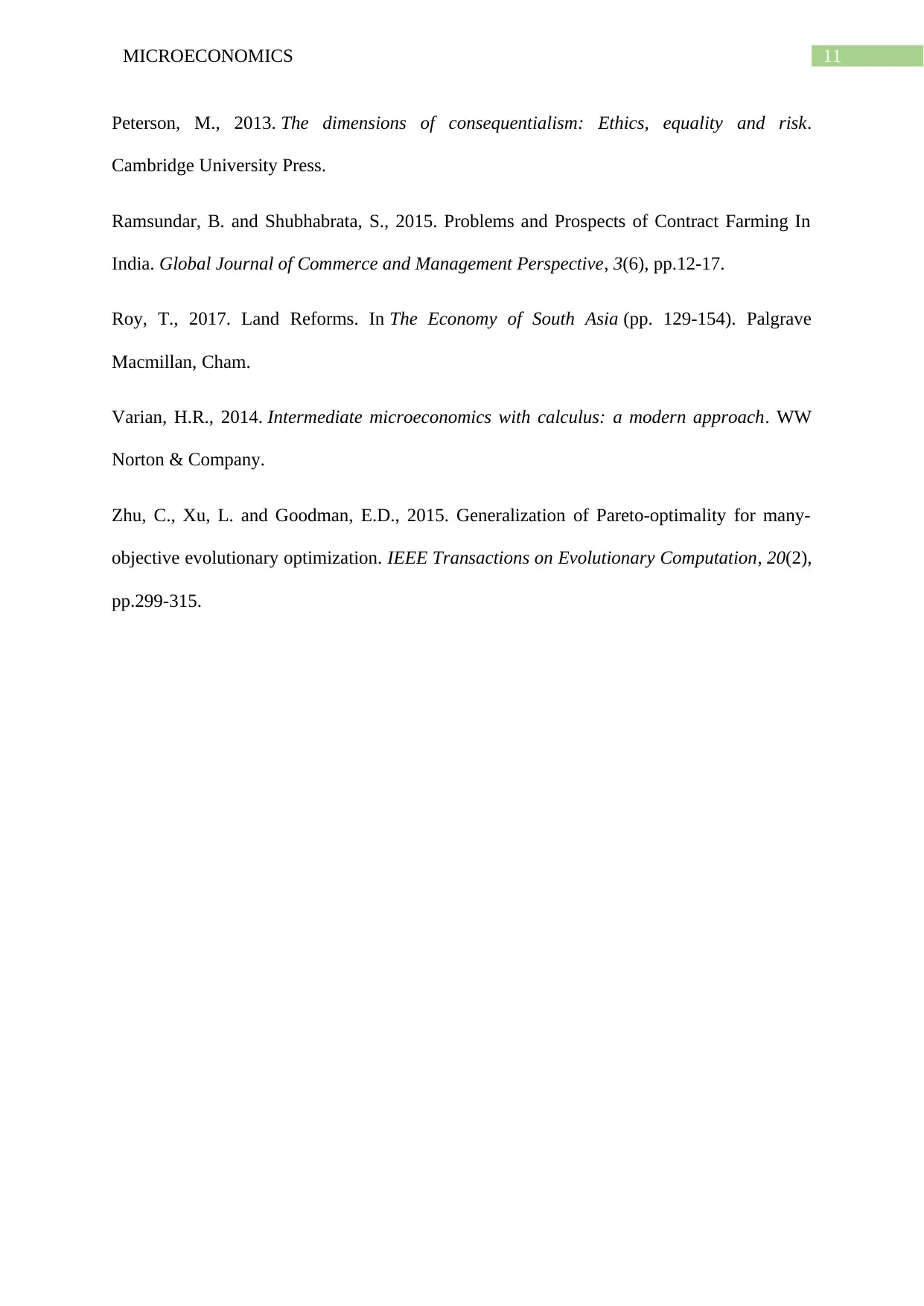
11MICROECONOMICS
Peterson, M., 2013. The dimensions of consequentialism: Ethics, equality and risk.
Cambridge University Press.
Ramsundar, B. and Shubhabrata, S., 2015. Problems and Prospects of Contract Farming In
India. Global Journal of Commerce and Management Perspective, 3(6), pp.12-17.
Roy, T., 2017. Land Reforms. In The Economy of South Asia (pp. 129-154). Palgrave
Macmillan, Cham.
Varian, H.R., 2014. Intermediate microeconomics with calculus: a modern approach. WW
Norton & Company.
Zhu, C., Xu, L. and Goodman, E.D., 2015. Generalization of Pareto-optimality for many-
objective evolutionary optimization. IEEE Transactions on Evolutionary Computation, 20(2),
pp.299-315.
Peterson, M., 2013. The dimensions of consequentialism: Ethics, equality and risk.
Cambridge University Press.
Ramsundar, B. and Shubhabrata, S., 2015. Problems and Prospects of Contract Farming In
India. Global Journal of Commerce and Management Perspective, 3(6), pp.12-17.
Roy, T., 2017. Land Reforms. In The Economy of South Asia (pp. 129-154). Palgrave
Macmillan, Cham.
Varian, H.R., 2014. Intermediate microeconomics with calculus: a modern approach. WW
Norton & Company.
Zhu, C., Xu, L. and Goodman, E.D., 2015. Generalization of Pareto-optimality for many-
objective evolutionary optimization. IEEE Transactions on Evolutionary Computation, 20(2),
pp.299-315.
1 out of 12
Related Documents
Your All-in-One AI-Powered Toolkit for Academic Success.
+13062052269
info@desklib.com
Available 24*7 on WhatsApp / Email
![[object Object]](/_next/static/media/star-bottom.7253800d.svg)
Unlock your academic potential
© 2024 | Zucol Services PVT LTD | All rights reserved.





